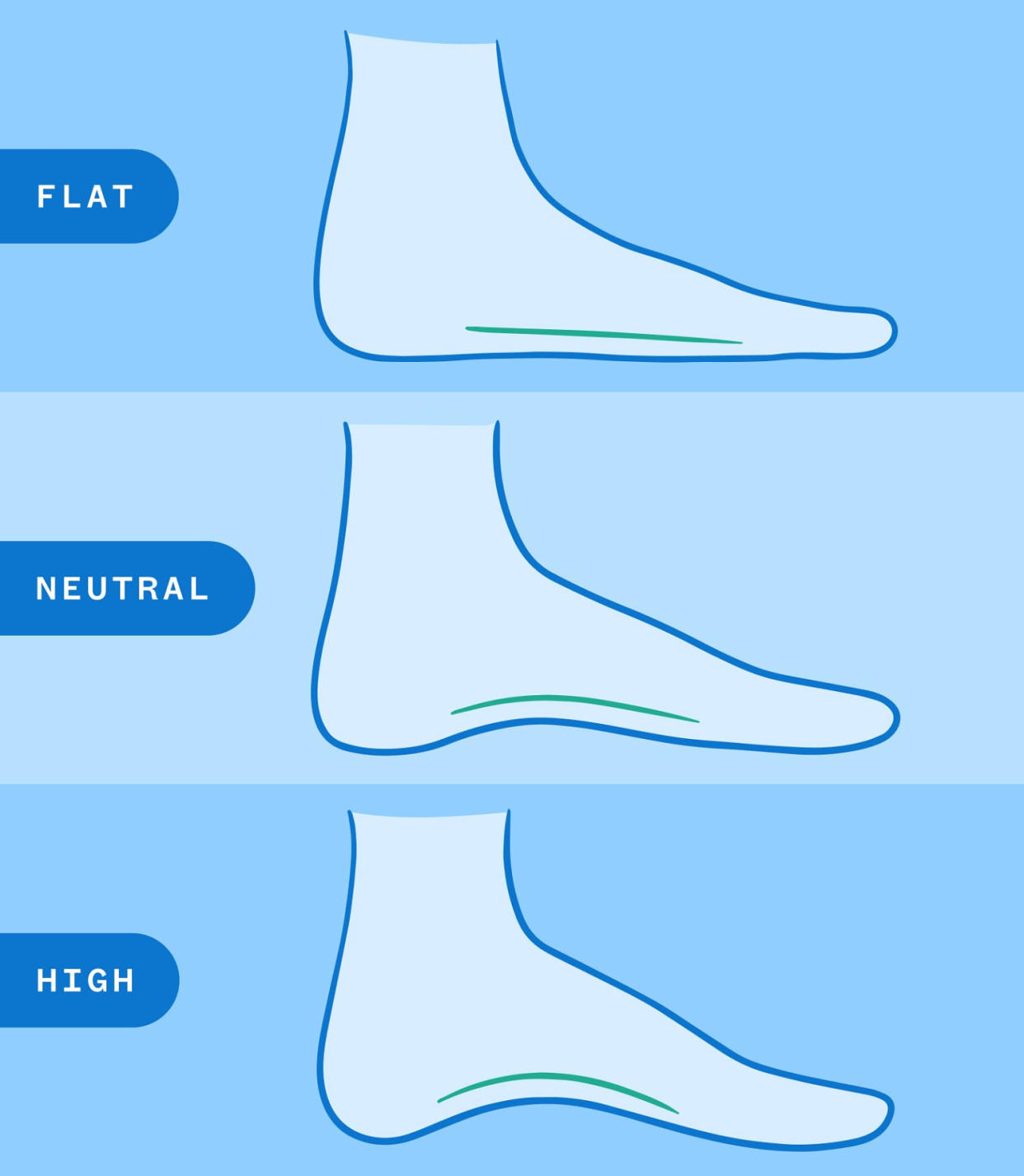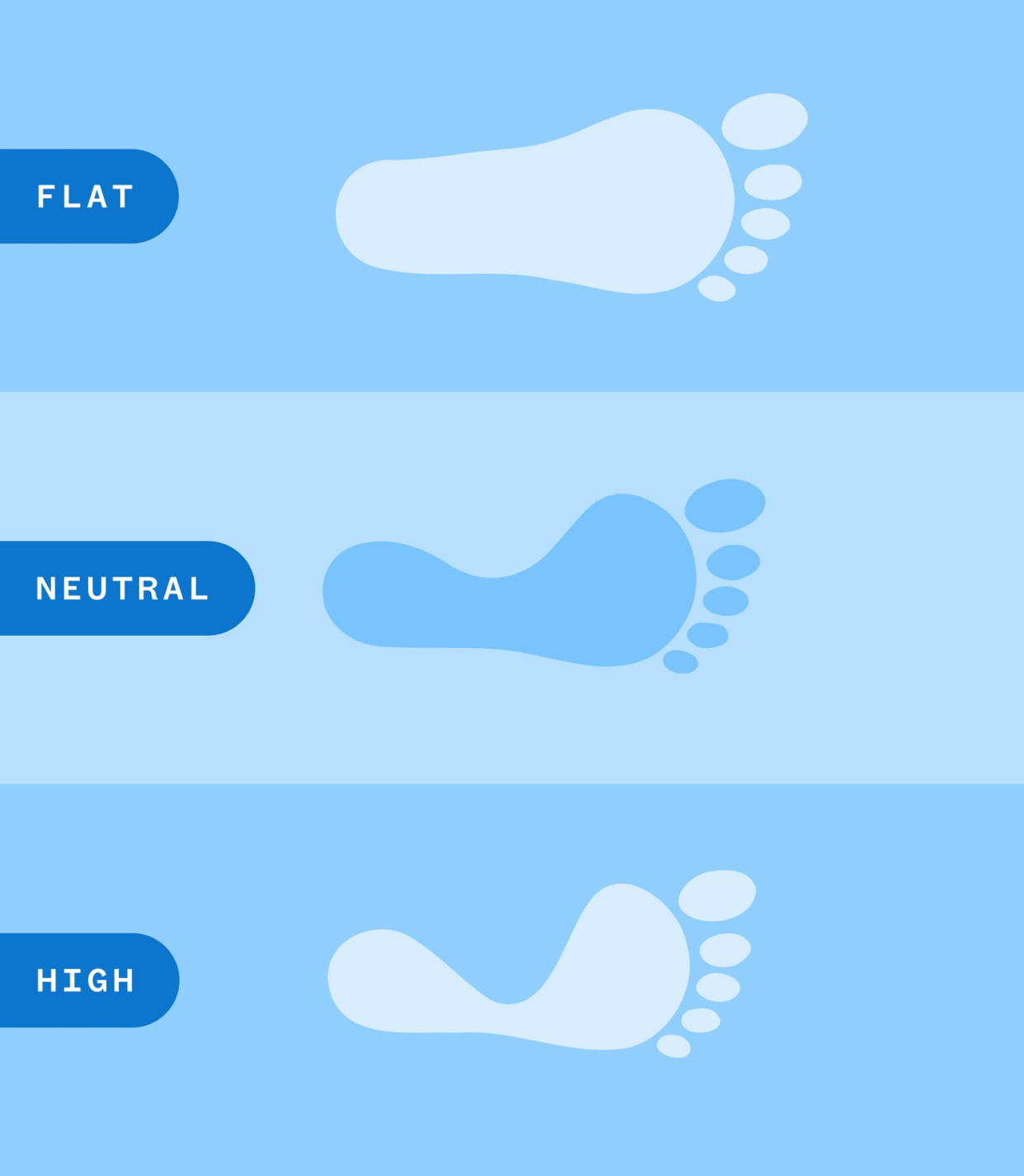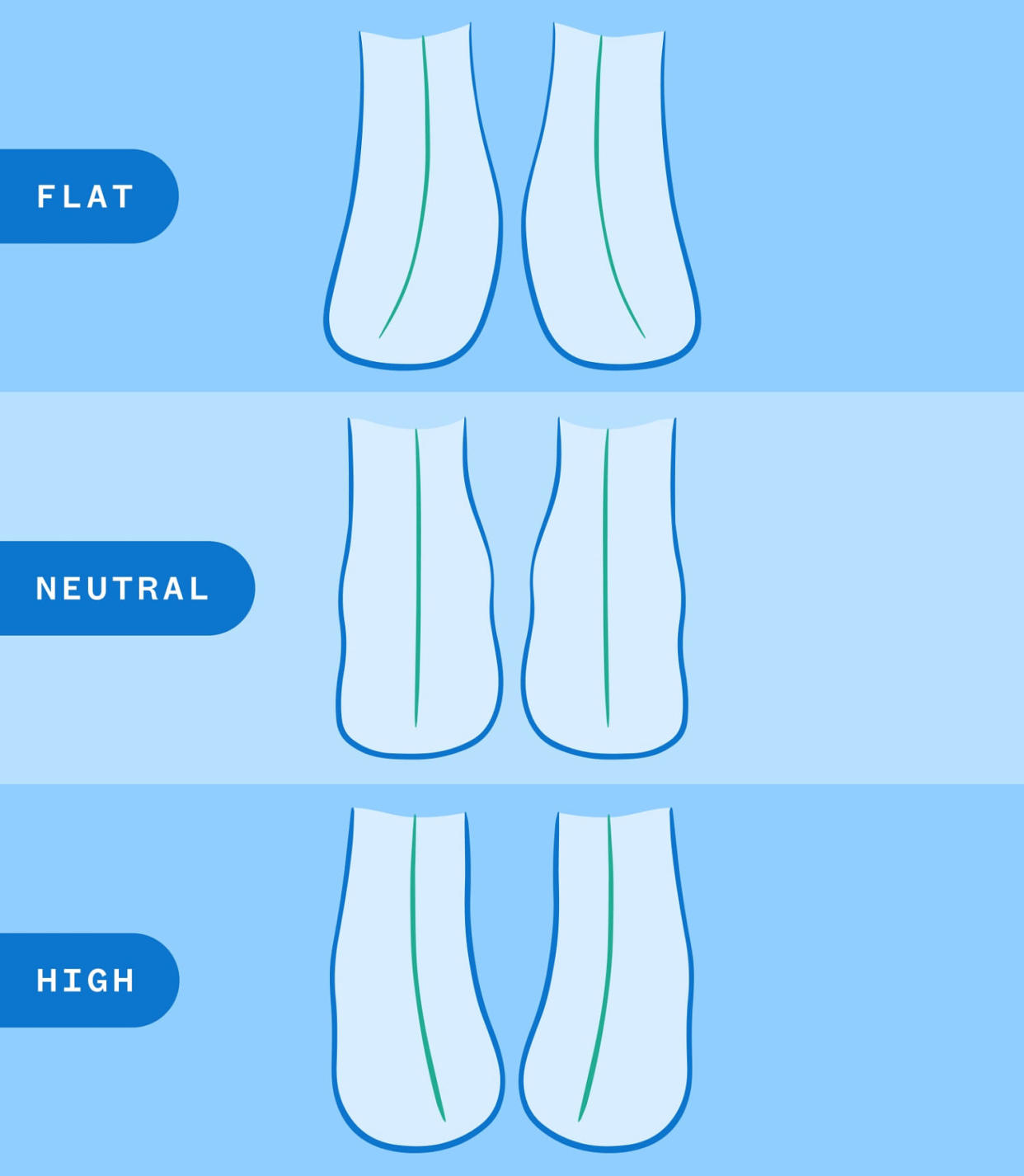This is why you should know your foot arch type
Select independently determines what we cover and recommend. When you buy through our links, we may earn a commission. Learn more.
Most people have no idea what arch type they have, but it’s one of the most important pieces of the puzzle to consider when you’re shopping for comfortable shoes, says Jewels Busenberg, the senior running buyer for Zappos.com (Ed’s note: The inclusion of products sold by Zappos in this article was made independently of Busenberg). Wearing the wrong shoes for your arch type adds stress to the feet, which may aggravate other parts of the body like the hips, knees and back. I’ve been running for over a decade, and as someone who tries new running shoes every month, I can now immediately tell whether a sneaker supports my arch or is going to cause pain a few miles in.
We talked to experts about how to determine your arch type and why doing so is important. We also rounded up the best shoes for each arch type that align with expert guidance, including some of our favorite models from Brooks, Vionic, Hoka, Birkenstock and more.
SKIP AHEAD Why is knowing your arch type important? | What are the different foot arch types? | How to identify your arch type | The best shoes for neutral arches | The best shoes for high arches | The best shoes for flat feet
Why is knowing your arch type important?
Knowing your arch type is important because it impacts the way you stand, walk and run, plus how different parts of your body interact, says Busenberg. And if you’re not wearing the proper footwear to support your arches, you may experience ankle, leg, knee, hip and back pain, or be more prone to certain injuries. “It relates to the body’s kinetic chain, which means that the rotation that happens in the feet can translate all the way up to the hips and back,” says Dr. Alicia Canzanese, a podiatrist, certified athletic trainer and owner of Gordon Podiatry in Glenside, Pennsylvania. “Think of it as the bottom of the body affecting the top, just as the top can affect the bottom.”
What are the different foot arch types?
There are a few arches in the foot, but when we talk about arch type, we’re referring to the arch in the middle of the foot. It spans the length of your underfoot and is created by bones, tendons and ligaments, says Busenberg. You can see it the best when you look at your feet from the side.
There are three arch types: neutral, high and flat. Each is defined by how much of your midfoot touches the ground.
Flat arch
If you have flat arches, also called flat feet or low arches, the middle part of your foot almost completely touches the ground. This can cause your ankles to tilt inward too much, which is called overpronation. Pronation is a natural, normal movement of the feet, and everyone pronates a little bit to help the body absorb some of the shock it experiences when we’re walking or running. But too much pronation causes the joints surrounding the feet, ankles and legs to compensate for that excessive rotation, which may increase your risk of big toe joint arthritis, knee pain and lower back pain, says Canzanese. Those with flat feet also tend to be prone to plantar fasciitis, shin splints and tendonitis in some areas.
Neutral arch
“A neutral arch is considered a normal foot,” says Canzanese. “It’s not too flat and it’s not too high. It’s cruising right in the middle.” You’ll see a little bit of space between the ground and the top of your foot’s arch if you look at it from the side.
High arch
If you have high arches, you’ll see a lot of space between the ground and the top of your arches. This usually causes your ankles to tilt outward too much, which is called oversupination. Similar to pronation, it’s normal to supinate a little bit — supination essentially stabilizes the foot and helps you push off the ground, propelling you forward while walking. But too much supination prevents your body from being able to absorb shock well. People with high arches tend to walk more on the outside of their feet, leading to an increased risk of ankle sprains, says Canzanese.

How to identify your foot arch type
There are a few ways to identify your foot type at home, some of which are more involved than others. We detailed the most common ways to figure it out below, but if you want more specific insights, like whether you have a moderate or severely high arch, be sure to talk to your podiatrist. They can do a gait examination in their office, during which they evaluate your feet while you’re standing and walking, says Dr. Maryann Hartzell, medical director of the Foot and Ankle Institute at Temple University’s School of Podiatric Medicine.
Wet footprint test
Dip your foot in water and step on a piece of cardboard or a piece of colored construction paper and then examine how wide the middle part of your footprint is.
If you have flat arches, your footprint will be very wide in the middle because more of your foot touches the ground.
If you have neutral arches, your footprint will be a bit narrower in the middle and wider by the toes.
If you have high arches, your footprint will be very narrow in the middle because less of your foot touches the ground. It will look like there’s a thin band connecting the ball of your foot to your heel, says Busenberg.

Too many toes test
Have someone stand behind you and look at your heels. How many of your toes can they see peeking out the side?
If you have flat arches, they’ll be able to see three or four of your toes.
If you have neutral arches, they’ll be able to see your pinky toe and maybe the toe next to it.
If you have high arches, they may not be able to see any of your toes.
Looking at heel and ankle position
Have someone stand behind you and look at the position of your heels and ankles.
If you have flat arches, that line starts to tilt outward as it gets closer to your heels.
If you have neutral arches, they should be able to draw a straight line down your Achilles and heel.
If you have high arches, that line starts to tilt inward as it gets closer to your heels.

The best shoes for every arch type
Once you figure out your arch type, you can buy shoes for activities like walking, running, training and hiking, as well as slippers and sandals, specifically designed to support your feet. Traditionally, shoes are broken down into three categories: neutral shoes, which are best for neutral arches, stability shoes, which are best for flat arches and cushioning shoes, which are best for people with high arches. Looking for these labels while shopping for shoes is a great start, but many shoes have recently become blends of two or all three categories, says Canzanese. Because of this, there’s a bit more nuance to the shoe shopping process, which we detail below, along with some of the best shoes for each arch type.
Keep in mind that breaking arch type down into neutral, high and flat is the most common and straightforward way of thinking about it, but it’s somewhat of an oversimplification, says Canzanese. There are different levels of severity for each arch type — you can have a slightly high arch or a very high arch, for example — and various overall foot types. Because of this, arch type is only one piece of the puzzle you need to think about while shopping for shoes — you also need to consider foot width, toe room and cushioning, for example.
The best shoes for neutral arches
Consider yourself lucky if you have neutral arches — it makes shopping for shoes very easy because it’s all about what you find comfortable. Look for a neutral shoe, which has level cushioning, a cushioned sole and a stable base, says Canzanese. Unlike stability shoes, which are designed to prevent overpronation, neutral shoes don’t impact how your feet move. They’re purely designed to keep your feet comfortable and supported.
The best shoes for high arches
Cushioning is crucial for people with high arches, says Canzanese. Their feet are rigid and prone to oversupination, so they need as much help absorbing shock as possible, which good shoe cushioning takes care of. While shopping, those with high arches should prioritize brands’ maximum cushioning models and flexible options that provide a soft landing, says Busenberg. Stay away from firm shoes, and those that have hard, thin soles, says Hartzell.
The best shoes for flat arches
If you have flat arches, you’ll want to invest in a pair of stability shoes, says Canzanese. They’re designed with features that help offset overpronation and prevent the ankles from tilting inward too much. Stability shoes are also firm and don’t have plush cushioning, says Busenberg. Brands add stability to shoes by:
Adding an extra piece of stiff material to the shoe’s midsole or sole
Adding a J-shaped strip of stiff material that wraps around your heel and toward your arch. Brooks calls this strip a GuideRail, for example.
Making the middle of the last of the shoe wider and stiffer (you can think of the last as a 3D model that a shoe is constructed around, says Canzanese).
Those with flat feet should stay away from high heels, opting for models with low heels or no added height, says Hartzell. High heels place the foot in an unnatural position that can be particularly painful for people with low arches. Also while shopping, keep in mind that there’s different levels of stability shoes — some offer a lower level of stability, which are best for people with moderately low arches, while others offer a high level of stability, which are best for people with severely flat feet. If you don’t know what level stability shoe you need, be sure to consult your podiatrist.
Meet our experts
At NBC Select, we work with experts who have specialized knowledge and authority based on relevant training and/or experience. We also take steps to ensure that all expert advice and recommendations are made independently and with no undisclosed financial conflicts of interest.
Jewels Busenberg is the senior running buyer for Zappos.com (Ed’s note: The inclusion of products sold by Zappos in this article was made independently of Busenberg).
Dr. Alicia Canzanese is a podiatrist, certified athletic trainer and owner of Gordon Podiatry in Glenside, Pennsylvania. She is the president of the American Academy of Podiatric Sports Medicine, adjunct professor in sports medicine and general orthopedics at the Temple University School of Podiatric Medicine in Philadelphia and an executive board member of the Pennsylvania Podiatric Medical Association.
Dr. Maryann Hartzell is the medical director of the Foot and Ankle Institute at Temple University’s School of Podiatric Medicine
Why trust NBC Select?
Zoe Malin is an associate updates editor at NBC Select who covers footwear, including stories on slippers, women’s walking shoes, running shoes and training shoes. She also frequently reviews sneakers, like the Brooks Ghost Max and Lululemon Chargefeel. For this article, she interviewed three experts about how to find your arch type and rounded shoes that fit expert guidance.
Catch up on NBC Select’s in-depth coverage of personal finance, tech and tools, wellness and more, and follow us on Facebook, Instagram, Twitter and TikTok to stay up to date.
